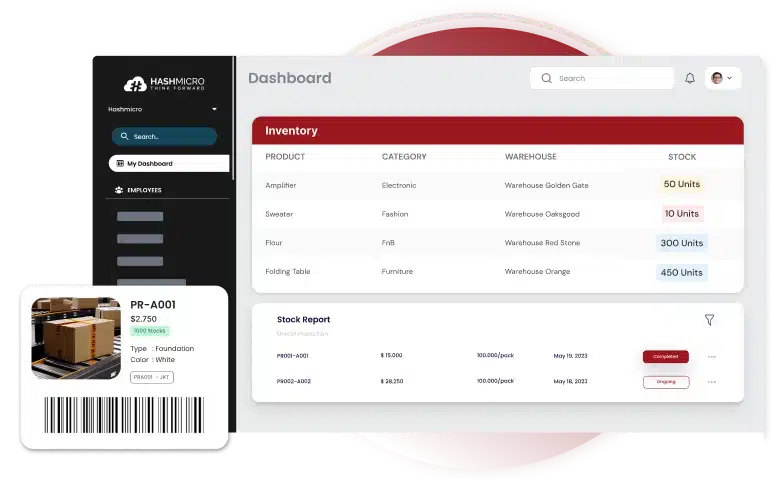Optimizing your warehouse is essential for an efficient retail supply chain. It impacts every aspect of your business, from inventory flow to customer satisfaction.
A well-optimized warehouse enhances productivity and ensures seamless operations. By streamlining processes and improving organization, you can maximize efficiency and deliver greater value to your customers.
To support this improvement, there’s also a CTC-Grants offer that can save you up to 70%, helping you adopt better warehouse management systems with lower investment.
So, here are eight tips you can implement to optimize your warehouse management.
Key Takeaways
|
How to Optimize Warehouse?
Warehouse optimization is a comprehensive and strategic approach focused on enhancing the overall efficiency, productivity, and accuracy of warehouse operations. This process is designed to reduce operational costs, increase throughput, and improve the customer experience by optimizing various aspects of the warehouse, such as layout design, technology integration, process reengineering, and employee training.
For eCommerce brands in particular, warehouse optimization targets the streamlining of essential operations like receiving, picking, packing, shipping, and managing returns. By optimizing these processes, eCommerce businesses can ensure that orders are processed quickly and cost-effectively, ultimately boosting customer satisfaction and operational efficiency.
Hashy AI Fact

Need to Know
Many businesses are shifting to AI-based warehouse optimization systems. The AI for Warehouse Management System automates inventory tracking and optimizes stock replenishment.
Request a free demo today!
The Benefits of Warehouse Optimization
1. Increased Operational Efficiency
Warehouse optimization streamlines processes, enabling faster order processing, reducing bottlenecks, and ensuring smoother operations overall.
2. Cost Reduction
By improving layout design, integrating technology, and refining processes, businesses can lower operational costs and minimize waste.
3. Enhanced Productivity
Optimized workflows with Easy AI and better resource management lead to higher productivity, allowing employees to work more effectively and focus on value-added tasks.
4. Improved Inventory Management
Efficient warehouse optimization ensures better inventory tracking and management, reducing the likelihood of stockouts or overstock situations.
5. Space Utilization
Optimizing warehouse layout maximizes the use of available space, reducing the need for additional storage facilities and cutting down on associated costs.
6. Higher Accuracy in Order Fulfillment
With improved processes and technology, warehouses can achieve greater accuracy in picking, packing, and shipping, minimizing errors and returns.
7. Faster Shipping Times
Streamlined operations lead to quicker order processing and shipping, enhancing customer satisfaction by meeting or exceeding delivery expectations.
8. Boosted Customer Satisfaction
Accurate and timely order fulfilment, coupled with reduced errors and faster shipping, leads to happier customers and increased loyalty.
9. Better Scalability
An optimized warehouse can more easily scale operations as the business grows, accommodating higher order volumes without sacrificing efficiency.
10. Competitive Advantage
By continuously improving warehouse operations, businesses can stay ahead of competitors, offering better service and more efficient delivery, which are key differentiators in today’s market.
8 Tips to Optimize Warehouse
Optimizing warehouse operations hinges on simplifying and streamlining processes wherever feasible. From designing efficient picking paths and strategically positioning inventory to leveraging robotics and warehouse management software (WMS) for automation, here are eight strategies businesses can use to enhance their warehouse environments.
- Minimize manual interventions: While employees are vital to successful warehouse operations, machines can handle repetitive and tedious tasks, freeing up staff for higher-value work. To facilitate the swift movement of inventory, businesses can automate simple tasks, allowing technology, such as robots and barcode tracking software, to manage picking, packing, and shipping processes.
- Balance storage capacity with operational efficiency: The ideal warehouse maximizes inventory storage while ensuring that inventory moves efficiently through various processes. Achieving this balance requires optimizing storage layout, effectively utilizing space, and continuously refining processes to ensure smooth inventory flow from one stage to the next.
- Invest in robotics and automation: Many businesses are increasingly turning to robots, drones, and automated storage and retrieval systems (AS/RS) to handle inventory movement. Large eCommerce companies have pioneered this approach, using automation to take over labor-intensive tasks. Robots not only alleviate physical labor for employees but also ensure that warehouse operations are more consistent, reliable, and safe.
- Align warehouse operations with business KPIs: With the pressure to maintain high-speed operations, it’s easy to lose sight of long-term business objectives. For instance, a car manufacturer may focus too much on a sudden demand for one model, neglecting the broader goal of building inventory for a new electric vehicle launch. It’s crucial to align warehouse metrics and key performance indicators (KPIs) with strategic business goals, rather than being swayed by short-term demands
- Automate shipping routing: Shipping and fulfillment are critical warehouse activities that must be optimized. Instead of relying on manual routing by employees, companies can implement order routing automation tools to streamline the process, ensuring that the correct products reach the right destination promptly.
- Organize inventory by product velocity: Product velocity, or the rate at which a product sells, often determines how quickly it needs to move through the warehouse. High-demand items, such as popular holiday gifts, heavily discounted products, or perishable goods, require quick processing. By organizing the warehouse layout to prioritize the retrieval and shipping of these items, businesses can better meet demand spikes and capitalize on sales opportunities.
- Stock inventory using logical sequencing: A well-organized warehouse is essential for smooth operations. To avoid losing or misplacing inventory, businesses should store products in locations that employees can easily and intuitively access. For example, a grocery warehouse would avoid placing perishable items on high shelves or in hard-to-reach areas. Logical sequencing in inventory placement ensures that items are easy to find, pick, pack, and ship, saving time and reducing the workload on employees.
- Implement warehouse management software (WMS): A WMS simplifies the complexity of managing warehouse operations by providing visibility across all processes and enabling the automation of time-consuming tasks. Businesses use Warehouse Management System to gain real-time insights into inventory levels and locations, helping them avoid overordering or understocking. WMS not only enhances operational efficiency but also helps prevent stock control issues, reduces unnecessary costs, and minimizes the risk of human error.
Checklist for Warehouse Optimization
1. Separate items based on the turnover ratio
To make it easier for pickers to find and pick ordered items, you should place your items based on the turnover ratio. Fast-moving goods are products that sell quickly at relatively low cost, while slow-moving goods are items that have had very little customer demand over a given period.
Put your best-selling products on the front shelves, so the pickers won’t have to walk far to find them. After all, make sure the fast-moving items are located not far from the packing and shipping area to speed up the order fulfillment process.
2. Improve Warehouse Neatness & Security
You will find it difficult to improve efficiency if you can’t improve your warehouse neatness and safety. When your warehouse is messy and not equipped with proper security, various risks such as loss and accidents will be hard to avoid.
Arrange your warehouse space and layout by optimally utilizing each area. Also, make sure that pallet jacks and forklifts can easily go through each aisle in your warehouse. You also need to make sure that you don’t mix multiple SKUs in the same bin location so that your staff won’t have to accidentally pick the wrong items.
Although one of your goals is to increase efficiency, your warehouse security must still be prioritized. Provide your employees with proper equipment to support their safety when picking and placing items. Lastly, complete your warehouse area with security camera systems and grant access only to those who are responsible for managing your warehouse.
3. Determine the Most Efficient Order Picking Method

Order-picking methods used by each retail company may not be the same. One order-picking solution may suit one business and not another. Also, it depends on the number of orders, the layout of the warehouse, the complexity, and the unique requirements of the company.
Here are the best order-picking methods that you can apply.
Zone Picking
Also known as pick-and-pass picking, this method requires staff to pick up items in a specified area. They must choose all SKUs located in a certain area.
If an order has multiple SKUs located in different areas, they must be taken in turns from each area. For example, when a picker has taken all SKUs from the first area, they can continue picking the items from the second area, and so on. Then, all the items taken can be placed directly into the packaging or shipping area.
Batch Picking
This method is used when you have multiple orders with the same SKU number. The picker must take items from several orders, with the same SKU number at the same time. Therefore, they only need to make one trip to pick up those items.
Cluster Picking
This method requires staff to take several items from several orders in one trip and then put them into different containers. When doing this, they will need a push cart consisting of multiple containers for different items.
Wave Picking
With this method, the picker must take items from one order, one SKU number, at a time. The schedules for picking up items can be determined at certain times of the day, to synchronize and optimize the picking and delivery processes.
Also Read: How to Improve Order Picking Productivity in Your Warehouse
4. Use Automated Inventory & Warehouse Management Solutions
Manually managing a warehouse while relying on paper records and spreadsheets is very inefficient. Imagine how much time has been wasted keeping track of the good movements and how much loss you have experienced due to inaccurate data or order fulfillment issues.
Your competitors may have been automating their warehouse and inventory management processes with automated solutions. So, why haven’t you?
Warehouse Management Software (WMS) makes it easier for you to monitor the entry and exit of goods, automate inventory audit procedures, and speed up the picking and packing processes to ensure timely order fulfillment. It also provides complete real-time data on inventory status, turnover ratio, item allocation, etc.
Complete and advanced WMS like HashMicro’s can be integrated with Inventory Management Software (IMS) to optimize your retail operations. This integration enables you to manage your stock levels and forecast demand for your products, thereby avoiding stock-outs, overstock, and unnecessary purchases. Check out these recommendations for the best inventory management software in Singapore.
Also Read: How Businesses Reduce Storage Costs with Inventory Software
5. Analyze Your Warehouse Performance
After implementing new processes and technologies, you need to measure and review your warehouse performance to ensure that they have a great impact on the productivity of your warehouse. So, here are some warehouse performance metrics that you should actively monitor:
Order Fill Rate: The percentage of items ordered from the amount of inventory on hand. This is also known as the demand satisfaction rate.
Order Picking Accuracy: The percentage of orders picked without errors both from choosing the product and the quantity.
On-Time Shipment to Customer: Percentage of orders sent on the requested or specified date. Successful retail companies usually have a level of timeliness of 97% or higher.
Warehouse Capacity: The physical and actual capacity of the warehouse area used for inventory storage.
Also read: What is WMS and How it differs from Supply Chain
Conclusion
Once you have succeeded in measuring the results of the new processes and technologies that you are implementing, you will be able to understand how and where you can continue to improve the efficiency and productivity of your warehouse.

For more information about how WMS and IMS can help optimize your warehouse management, please visit our website or discuss your requirements with us.
FAQ about Warehouse Management Optimization
-
What are the key benefits of using warehouse management software?
Warehouse management software automates processes like inventory tracking, order processing, and shipping, which reduces manual errors and boosts overall efficiency. It also provides real-time data and analytics, helping businesses make informed decisions and optimize their operations.
-
How can real-time data improve warehouse management?
Real-time data allows businesses to monitor inventory levels, track orders, and analyze warehouse performance instantly. This enables better decision-making, helps prevent stockouts or overstocking, and improves operational efficiency.
-
How does integrating a warehouse management system with other systems benefit a business?
Integrating your warehouse management system with other systems like ERP and CRM ensures seamless data flow across departments. This leads to more coordinated operations, better communication, and an overall smoother business process.




















































